Financial Accounting Theory: Critical Essays for ACCT301, Semester 1
VerifiedAdded on 2022/10/06
|13
|2875
|15
Report
AI Summary
This report provides an in-depth analysis of financial accounting theory, addressing key concepts and frameworks. It begins by defining and explaining the significance of conceptual frameworks in financial accounting and disclosure, highlighting their benefits and limitations. The report then explores the objective of general purpose financial reporting as per the AASB Framework, discussing decision usefulness and stewardship roles, and the assessment methods used. Finally, it examines the historical cost method, comparing it to current cost accounting and other valuation techniques, and analyzing the arguments for and against its use, especially in comparison to fair value accounting. The report draws on various sources to support its arguments and provides a comprehensive overview of the discussed topics.
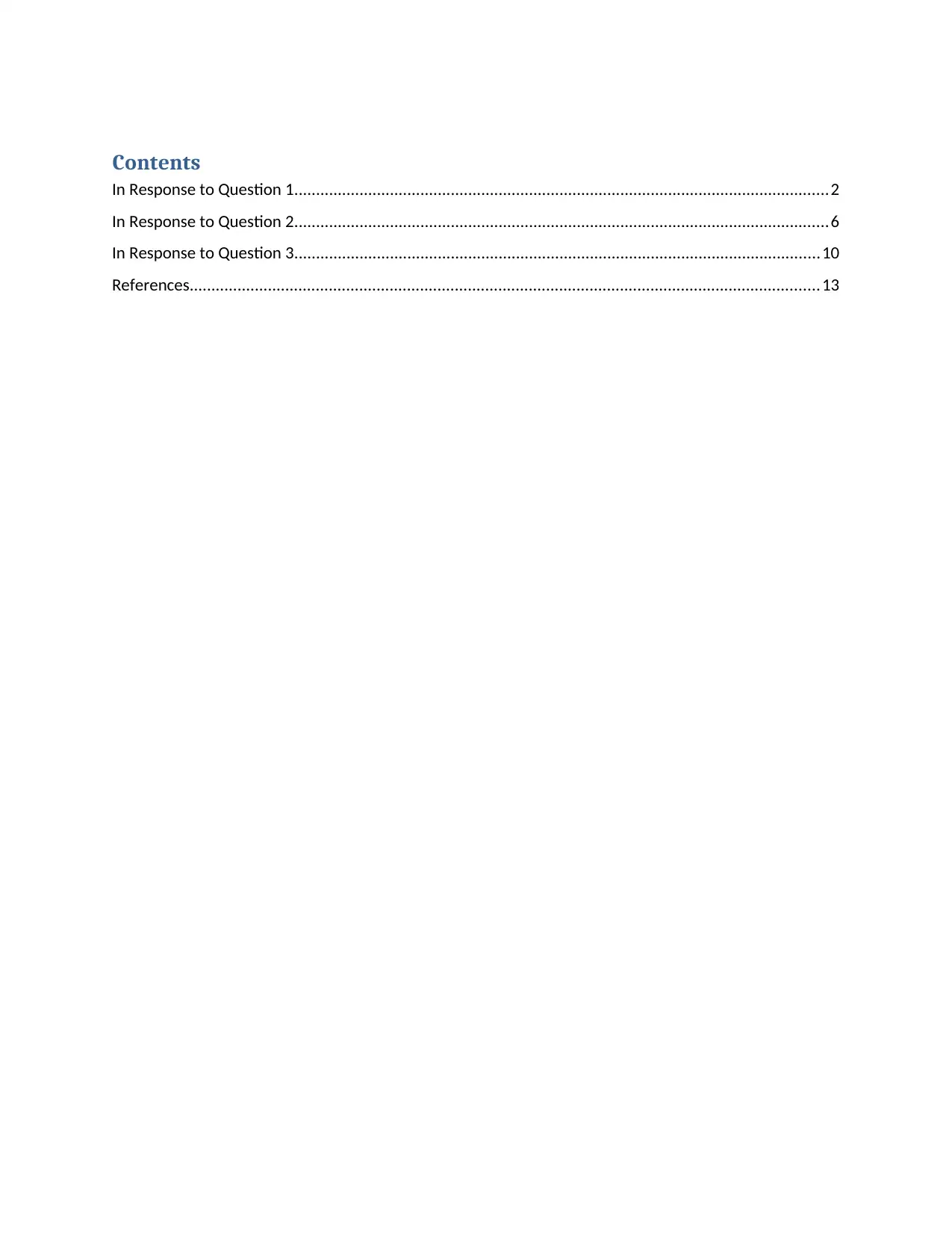
Contents
In Response to Question 1...........................................................................................................................2
In Response to Question 2...........................................................................................................................6
In Response to Question 3.........................................................................................................................10
References.................................................................................................................................................13
In Response to Question 1...........................................................................................................................2
In Response to Question 2...........................................................................................................................6
In Response to Question 3.........................................................................................................................10
References.................................................................................................................................................13
Secure Best Marks with AI Grader
Need help grading? Try our AI Grader for instant feedback on your assignments.
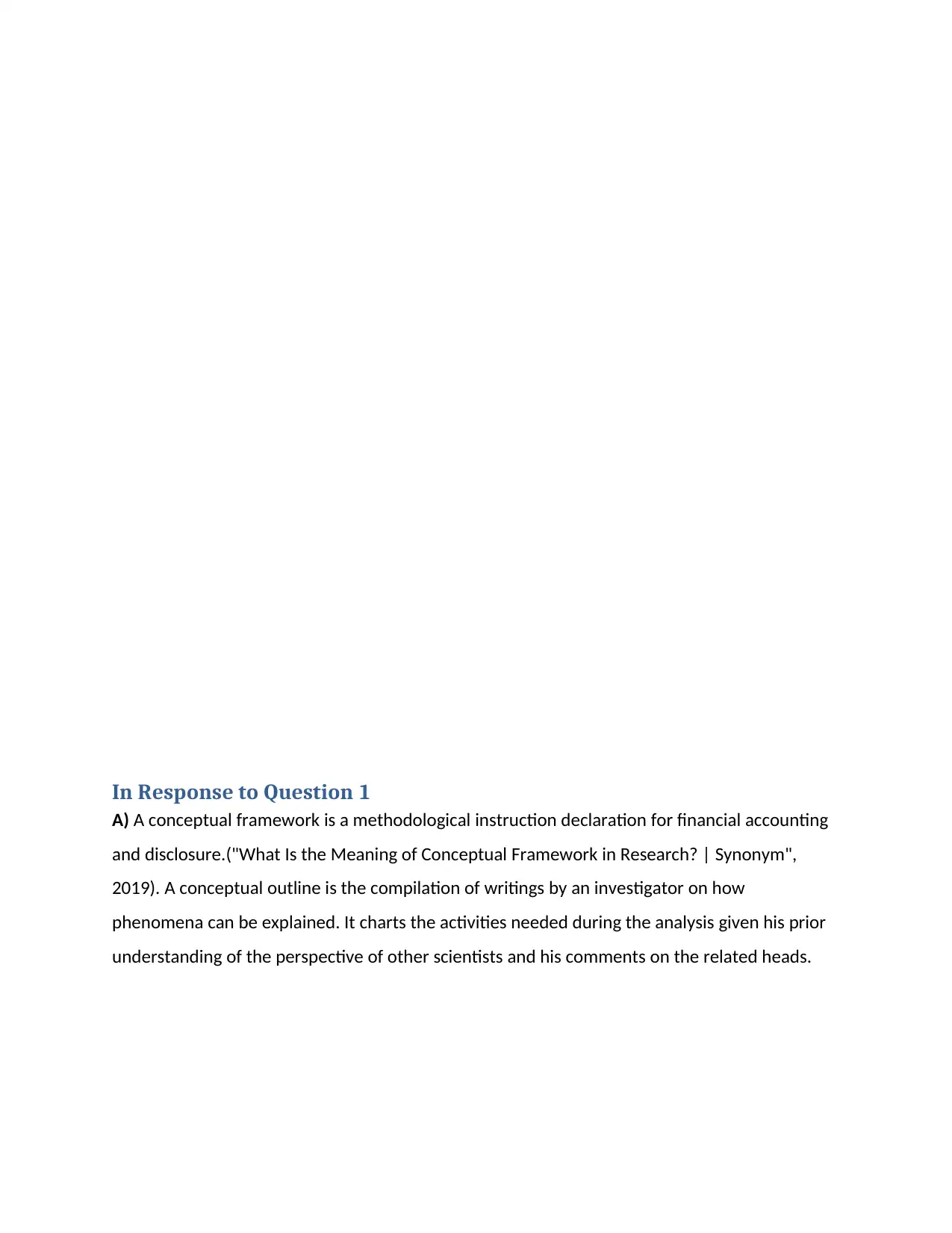
In Response to Question 1
A) A conceptual framework is a methodological instruction declaration for financial accounting
and disclosure.("What Is the Meaning of Conceptual Framework in Research? | Synonym",
2019). A conceptual outline is the compilation of writings by an investigator on how
phenomena can be explained. It charts the activities needed during the analysis given his prior
understanding of the perspective of other scientists and his comments on the related heads.
A) A conceptual framework is a methodological instruction declaration for financial accounting
and disclosure.("What Is the Meaning of Conceptual Framework in Research? | Synonym",
2019). A conceptual outline is the compilation of writings by an investigator on how
phenomena can be explained. It charts the activities needed during the analysis given his prior
understanding of the perspective of other scientists and his comments on the related heads.
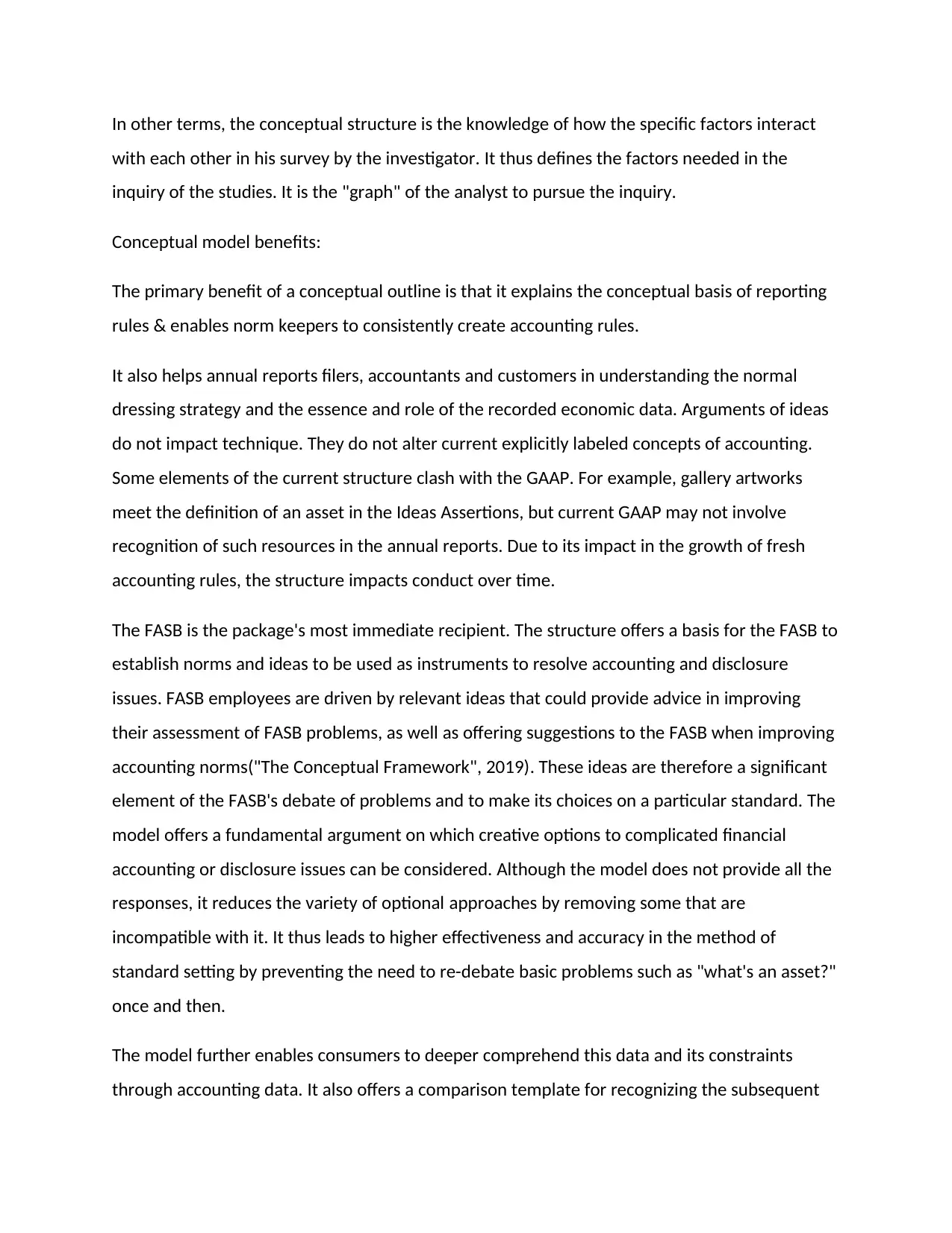
In other terms, the conceptual structure is the knowledge of how the specific factors interact
with each other in his survey by the investigator. It thus defines the factors needed in the
inquiry of the studies. It is the "graph" of the analyst to pursue the inquiry.
Conceptual model benefits:
The primary benefit of a conceptual outline is that it explains the conceptual basis of reporting
rules & enables norm keepers to consistently create accounting rules.
It also helps annual reports filers, accountants and customers in understanding the normal
dressing strategy and the essence and role of the recorded economic data. Arguments of ideas
do not impact technique. They do not alter current explicitly labeled concepts of accounting.
Some elements of the current structure clash with the GAAP. For example, gallery artworks
meet the definition of an asset in the Ideas Assertions, but current GAAP may not involve
recognition of such resources in the annual reports. Due to its impact in the growth of fresh
accounting rules, the structure impacts conduct over time.
The FASB is the package's most immediate recipient. The structure offers a basis for the FASB to
establish norms and ideas to be used as instruments to resolve accounting and disclosure
issues. FASB employees are driven by relevant ideas that could provide advice in improving
their assessment of FASB problems, as well as offering suggestions to the FASB when improving
accounting norms("The Conceptual Framework", 2019). These ideas are therefore a significant
element of the FASB's debate of problems and to make its choices on a particular standard. The
model offers a fundamental argument on which creative options to complicated financial
accounting or disclosure issues can be considered. Although the model does not provide all the
responses, it reduces the variety of optional approaches by removing some that are
incompatible with it. It thus leads to higher effectiveness and accuracy in the method of
standard setting by preventing the need to re-debate basic problems such as "what's an asset?"
once and then.
The model further enables consumers to deeper comprehend this data and its constraints
through accounting data. It also offers a comparison template for recognizing the subsequent
with each other in his survey by the investigator. It thus defines the factors needed in the
inquiry of the studies. It is the "graph" of the analyst to pursue the inquiry.
Conceptual model benefits:
The primary benefit of a conceptual outline is that it explains the conceptual basis of reporting
rules & enables norm keepers to consistently create accounting rules.
It also helps annual reports filers, accountants and customers in understanding the normal
dressing strategy and the essence and role of the recorded economic data. Arguments of ideas
do not impact technique. They do not alter current explicitly labeled concepts of accounting.
Some elements of the current structure clash with the GAAP. For example, gallery artworks
meet the definition of an asset in the Ideas Assertions, but current GAAP may not involve
recognition of such resources in the annual reports. Due to its impact in the growth of fresh
accounting rules, the structure impacts conduct over time.
The FASB is the package's most immediate recipient. The structure offers a basis for the FASB to
establish norms and ideas to be used as instruments to resolve accounting and disclosure
issues. FASB employees are driven by relevant ideas that could provide advice in improving
their assessment of FASB problems, as well as offering suggestions to the FASB when improving
accounting norms("The Conceptual Framework", 2019). These ideas are therefore a significant
element of the FASB's debate of problems and to make its choices on a particular standard. The
model offers a fundamental argument on which creative options to complicated financial
accounting or disclosure issues can be considered. Although the model does not provide all the
responses, it reduces the variety of optional approaches by removing some that are
incompatible with it. It thus leads to higher effectiveness and accuracy in the method of
standard setting by preventing the need to re-debate basic problems such as "what's an asset?"
once and then.
The model further enables consumers to deeper comprehend this data and its constraints
through accounting data. It also offers a comparison template for recognizing the subsequent
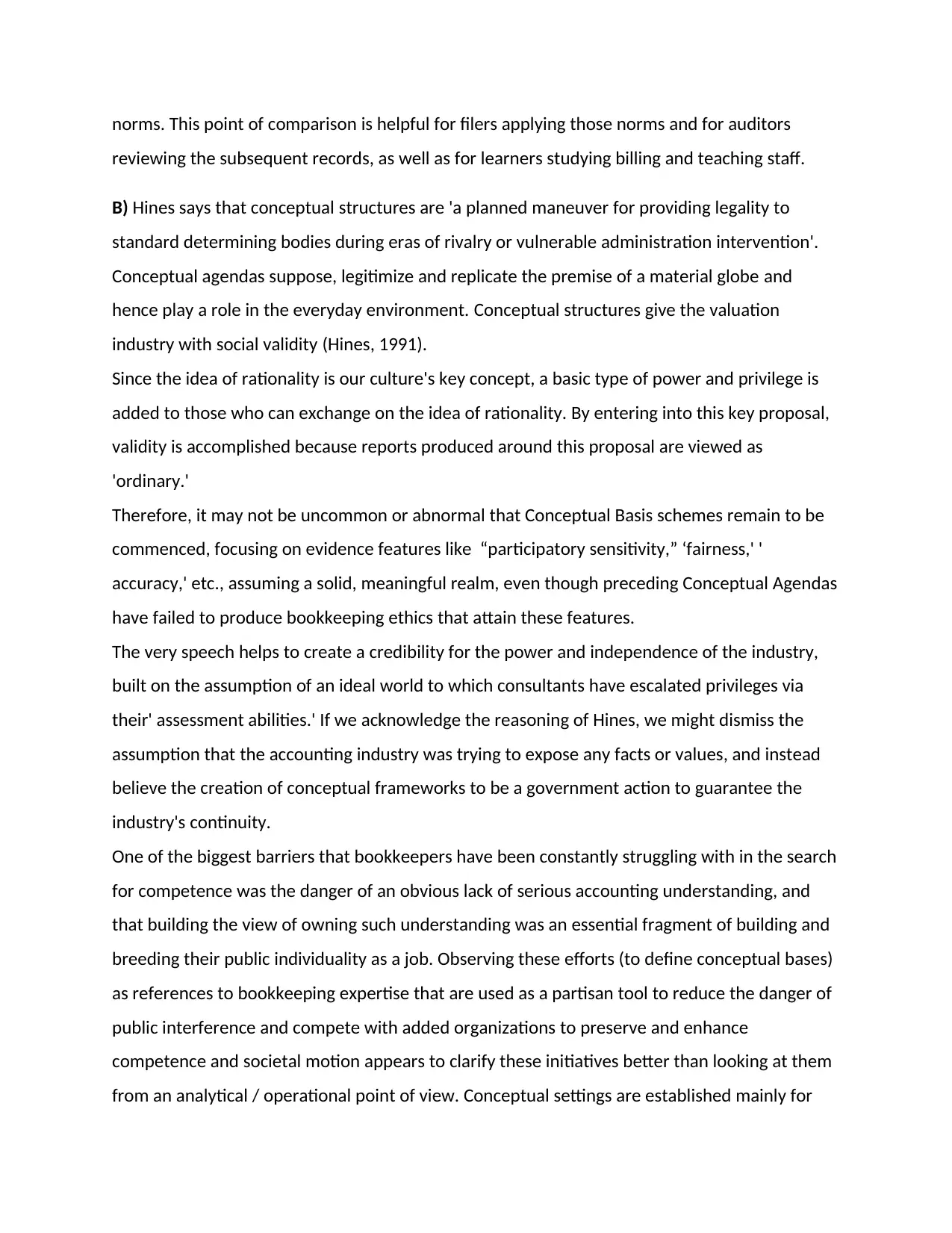
norms. This point of comparison is helpful for filers applying those norms and for auditors
reviewing the subsequent records, as well as for learners studying billing and teaching staff.
B) Hines says that conceptual structures are 'a planned maneuver for providing legality to
standard determining bodies during eras of rivalry or vulnerable administration intervention'.
Conceptual agendas suppose, legitimize and replicate the premise of a material globe and
hence play a role in the everyday environment. Conceptual structures give the valuation
industry with social validity (Hines, 1991).
Since the idea of rationality is our culture's key concept, a basic type of power and privilege is
added to those who can exchange on the idea of rationality. By entering into this key proposal,
validity is accomplished because reports produced around this proposal are viewed as
'ordinary.'
Therefore, it may not be uncommon or abnormal that Conceptual Basis schemes remain to be
commenced, focusing on evidence features like “participatory sensitivity,” ‘fairness,' '
accuracy,' etc., assuming a solid, meaningful realm, even though preceding Conceptual Agendas
have failed to produce bookkeeping ethics that attain these features.
The very speech helps to create a credibility for the power and independence of the industry,
built on the assumption of an ideal world to which consultants have escalated privileges via
their' assessment abilities.' If we acknowledge the reasoning of Hines, we might dismiss the
assumption that the accounting industry was trying to expose any facts or values, and instead
believe the creation of conceptual frameworks to be a government action to guarantee the
industry's continuity.
One of the biggest barriers that bookkeepers have been constantly struggling with in the search
for competence was the danger of an obvious lack of serious accounting understanding, and
that building the view of owning such understanding was an essential fragment of building and
breeding their public individuality as a job. Observing these efforts (to define conceptual bases)
as references to bookkeeping expertise that are used as a partisan tool to reduce the danger of
public interference and compete with added organizations to preserve and enhance
competence and societal motion appears to clarify these initiatives better than looking at them
from an analytical / operational point of view. Conceptual settings are established mainly for
reviewing the subsequent records, as well as for learners studying billing and teaching staff.
B) Hines says that conceptual structures are 'a planned maneuver for providing legality to
standard determining bodies during eras of rivalry or vulnerable administration intervention'.
Conceptual agendas suppose, legitimize and replicate the premise of a material globe and
hence play a role in the everyday environment. Conceptual structures give the valuation
industry with social validity (Hines, 1991).
Since the idea of rationality is our culture's key concept, a basic type of power and privilege is
added to those who can exchange on the idea of rationality. By entering into this key proposal,
validity is accomplished because reports produced around this proposal are viewed as
'ordinary.'
Therefore, it may not be uncommon or abnormal that Conceptual Basis schemes remain to be
commenced, focusing on evidence features like “participatory sensitivity,” ‘fairness,' '
accuracy,' etc., assuming a solid, meaningful realm, even though preceding Conceptual Agendas
have failed to produce bookkeeping ethics that attain these features.
The very speech helps to create a credibility for the power and independence of the industry,
built on the assumption of an ideal world to which consultants have escalated privileges via
their' assessment abilities.' If we acknowledge the reasoning of Hines, we might dismiss the
assumption that the accounting industry was trying to expose any facts or values, and instead
believe the creation of conceptual frameworks to be a government action to guarantee the
industry's continuity.
One of the biggest barriers that bookkeepers have been constantly struggling with in the search
for competence was the danger of an obvious lack of serious accounting understanding, and
that building the view of owning such understanding was an essential fragment of building and
breeding their public individuality as a job. Observing these efforts (to define conceptual bases)
as references to bookkeeping expertise that are used as a partisan tool to reduce the danger of
public interference and compete with added organizations to preserve and enhance
competence and societal motion appears to clarify these initiatives better than looking at them
from an analytical / operational point of view. Conceptual settings are established mainly for
Secure Best Marks with AI Grader
Need help grading? Try our AI Grader for instant feedback on your assignments.
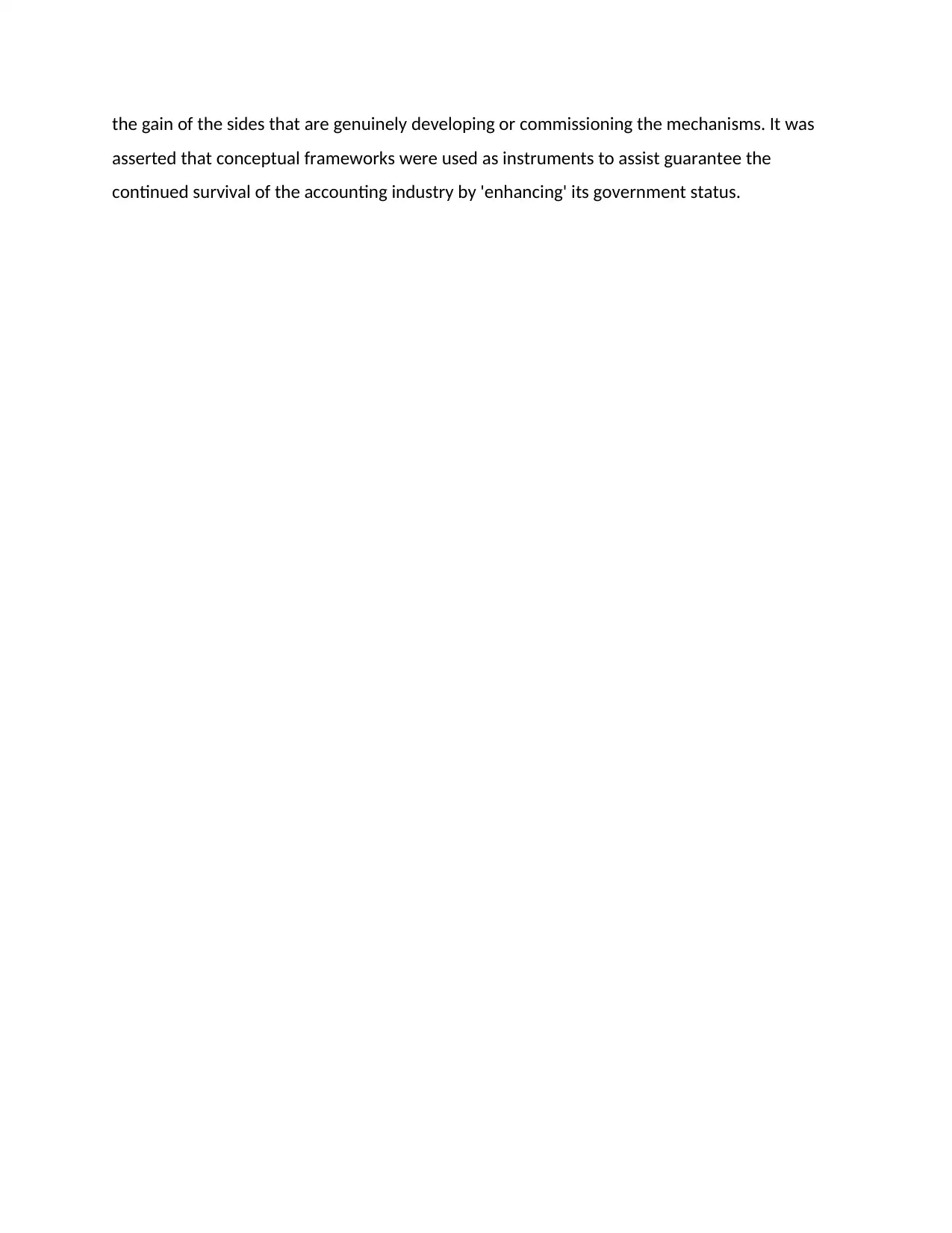
the gain of the sides that are genuinely developing or commissioning the mechanisms. It was
asserted that conceptual frameworks were used as instruments to assist guarantee the
continued survival of the accounting industry by 'enhancing' its government status.
asserted that conceptual frameworks were used as instruments to assist guarantee the
continued survival of the accounting industry by 'enhancing' its government status.
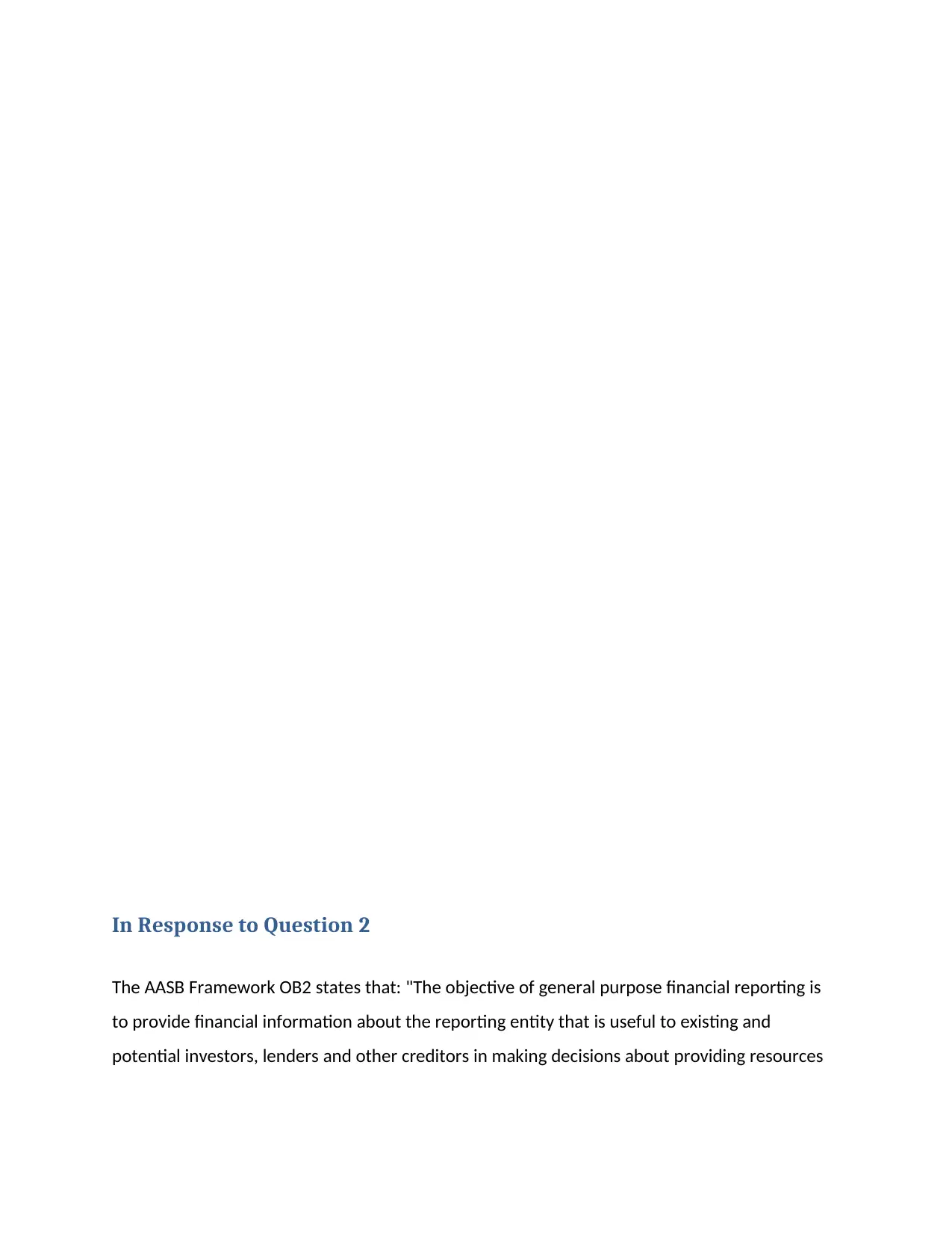
In Response to Question 2
The AASB Framework OB2 states that: "The objective of general purpose financial reporting is
to provide financial information about the reporting entity that is useful to existing and
potential investors, lenders and other creditors in making decisions about providing resources
The AASB Framework OB2 states that: "The objective of general purpose financial reporting is
to provide financial information about the reporting entity that is useful to existing and
potential investors, lenders and other creditors in making decisions about providing resources
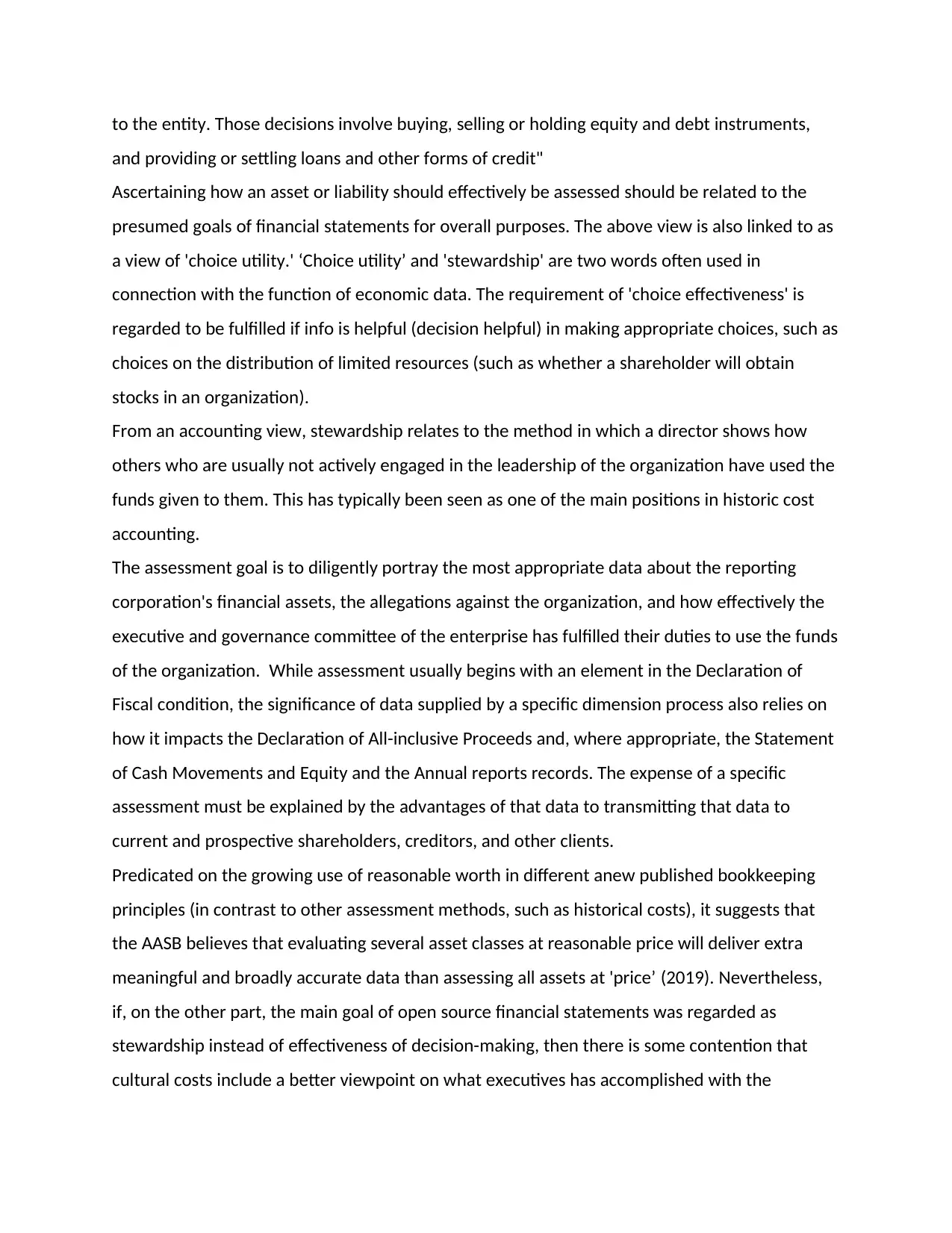
to the entity. Those decisions involve buying, selling or holding equity and debt instruments,
and providing or settling loans and other forms of credit"
Ascertaining how an asset or liability should effectively be assessed should be related to the
presumed goals of financial statements for overall purposes. The above view is also linked to as
a view of 'choice utility.' ‘Choice utility’ and 'stewardship' are two words often used in
connection with the function of economic data. The requirement of 'choice effectiveness' is
regarded to be fulfilled if info is helpful (decision helpful) in making appropriate choices, such as
choices on the distribution of limited resources (such as whether a shareholder will obtain
stocks in an organization).
From an accounting view, stewardship relates to the method in which a director shows how
others who are usually not actively engaged in the leadership of the organization have used the
funds given to them. This has typically been seen as one of the main positions in historic cost
accounting.
The assessment goal is to diligently portray the most appropriate data about the reporting
corporation's financial assets, the allegations against the organization, and how effectively the
executive and governance committee of the enterprise has fulfilled their duties to use the funds
of the organization. While assessment usually begins with an element in the Declaration of
Fiscal condition, the significance of data supplied by a specific dimension process also relies on
how it impacts the Declaration of All-inclusive Proceeds and, where appropriate, the Statement
of Cash Movements and Equity and the Annual reports records. The expense of a specific
assessment must be explained by the advantages of that data to transmitting that data to
current and prospective shareholders, creditors, and other clients.
Predicated on the growing use of reasonable worth in different anew published bookkeeping
principles (in contrast to other assessment methods, such as historical costs), it suggests that
the AASB believes that evaluating several asset classes at reasonable price will deliver extra
meaningful and broadly accurate data than assessing all assets at 'price’ (2019). Nevertheless,
if, on the other part, the main goal of open source financial statements was regarded as
stewardship instead of effectiveness of decision-making, then there is some contention that
cultural costs include a better viewpoint on what executives has accomplished with the
and providing or settling loans and other forms of credit"
Ascertaining how an asset or liability should effectively be assessed should be related to the
presumed goals of financial statements for overall purposes. The above view is also linked to as
a view of 'choice utility.' ‘Choice utility’ and 'stewardship' are two words often used in
connection with the function of economic data. The requirement of 'choice effectiveness' is
regarded to be fulfilled if info is helpful (decision helpful) in making appropriate choices, such as
choices on the distribution of limited resources (such as whether a shareholder will obtain
stocks in an organization).
From an accounting view, stewardship relates to the method in which a director shows how
others who are usually not actively engaged in the leadership of the organization have used the
funds given to them. This has typically been seen as one of the main positions in historic cost
accounting.
The assessment goal is to diligently portray the most appropriate data about the reporting
corporation's financial assets, the allegations against the organization, and how effectively the
executive and governance committee of the enterprise has fulfilled their duties to use the funds
of the organization. While assessment usually begins with an element in the Declaration of
Fiscal condition, the significance of data supplied by a specific dimension process also relies on
how it impacts the Declaration of All-inclusive Proceeds and, where appropriate, the Statement
of Cash Movements and Equity and the Annual reports records. The expense of a specific
assessment must be explained by the advantages of that data to transmitting that data to
current and prospective shareholders, creditors, and other clients.
Predicated on the growing use of reasonable worth in different anew published bookkeeping
principles (in contrast to other assessment methods, such as historical costs), it suggests that
the AASB believes that evaluating several asset classes at reasonable price will deliver extra
meaningful and broadly accurate data than assessing all assets at 'price’ (2019). Nevertheless,
if, on the other part, the main goal of open source financial statements was regarded as
stewardship instead of effectiveness of decision-making, then there is some contention that
cultural costs include a better viewpoint on what executives has accomplished with the
Paraphrase This Document
Need a fresh take? Get an instant paraphrase of this document with our AI Paraphraser
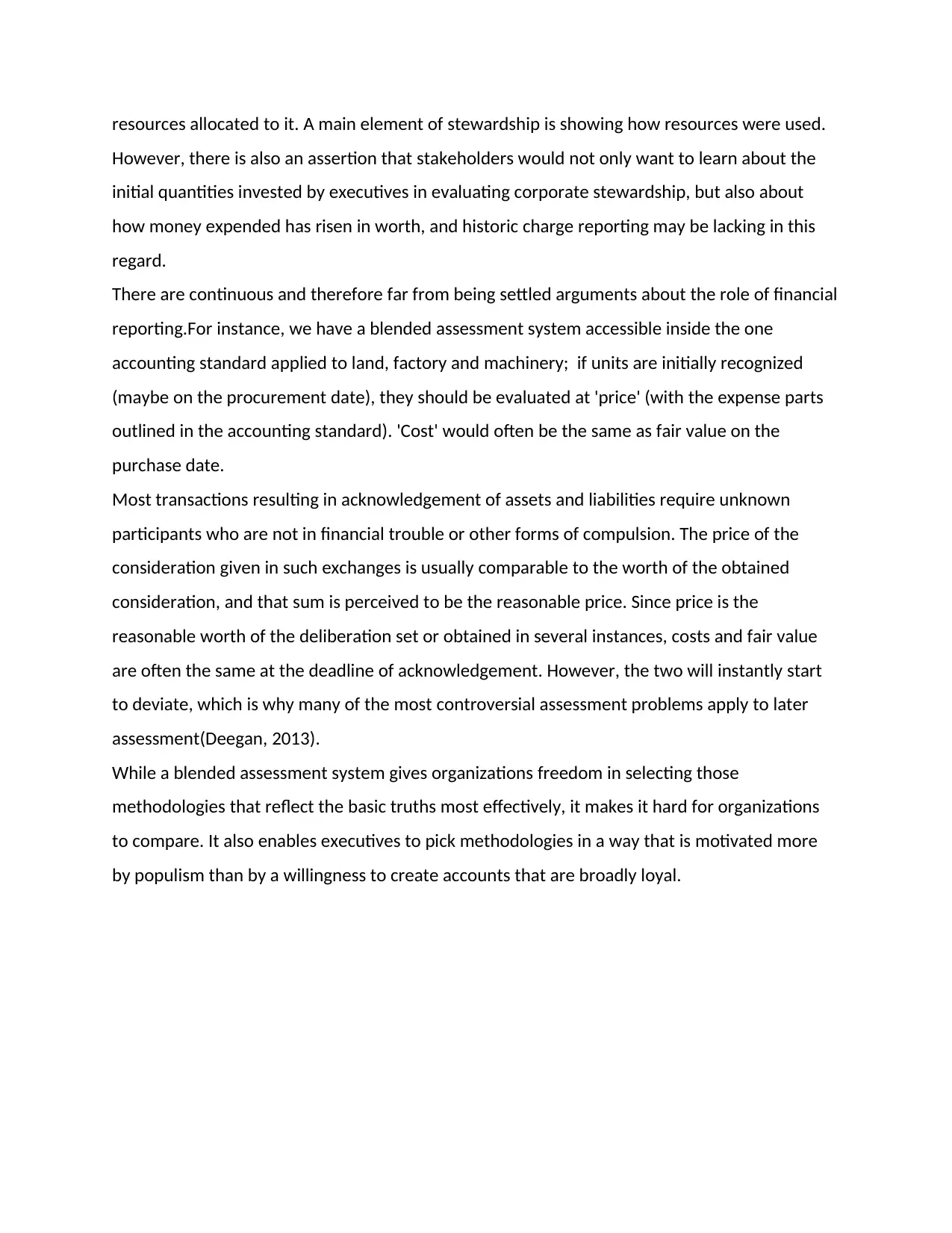
resources allocated to it. A main element of stewardship is showing how resources were used.
However, there is also an assertion that stakeholders would not only want to learn about the
initial quantities invested by executives in evaluating corporate stewardship, but also about
how money expended has risen in worth, and historic charge reporting may be lacking in this
regard.
There are continuous and therefore far from being settled arguments about the role of financial
reporting.For instance, we have a blended assessment system accessible inside the one
accounting standard applied to land, factory and machinery; if units are initially recognized
(maybe on the procurement date), they should be evaluated at 'price' (with the expense parts
outlined in the accounting standard). 'Cost' would often be the same as fair value on the
purchase date.
Most transactions resulting in acknowledgement of assets and liabilities require unknown
participants who are not in financial trouble or other forms of compulsion. The price of the
consideration given in such exchanges is usually comparable to the worth of the obtained
consideration, and that sum is perceived to be the reasonable price. Since price is the
reasonable worth of the deliberation set or obtained in several instances, costs and fair value
are often the same at the deadline of acknowledgement. However, the two will instantly start
to deviate, which is why many of the most controversial assessment problems apply to later
assessment(Deegan, 2013).
While a blended assessment system gives organizations freedom in selecting those
methodologies that reflect the basic truths most effectively, it makes it hard for organizations
to compare. It also enables executives to pick methodologies in a way that is motivated more
by populism than by a willingness to create accounts that are broadly loyal.
However, there is also an assertion that stakeholders would not only want to learn about the
initial quantities invested by executives in evaluating corporate stewardship, but also about
how money expended has risen in worth, and historic charge reporting may be lacking in this
regard.
There are continuous and therefore far from being settled arguments about the role of financial
reporting.For instance, we have a blended assessment system accessible inside the one
accounting standard applied to land, factory and machinery; if units are initially recognized
(maybe on the procurement date), they should be evaluated at 'price' (with the expense parts
outlined in the accounting standard). 'Cost' would often be the same as fair value on the
purchase date.
Most transactions resulting in acknowledgement of assets and liabilities require unknown
participants who are not in financial trouble or other forms of compulsion. The price of the
consideration given in such exchanges is usually comparable to the worth of the obtained
consideration, and that sum is perceived to be the reasonable price. Since price is the
reasonable worth of the deliberation set or obtained in several instances, costs and fair value
are often the same at the deadline of acknowledgement. However, the two will instantly start
to deviate, which is why many of the most controversial assessment problems apply to later
assessment(Deegan, 2013).
While a blended assessment system gives organizations freedom in selecting those
methodologies that reflect the basic truths most effectively, it makes it hard for organizations
to compare. It also enables executives to pick methodologies in a way that is motivated more
by populism than by a willingness to create accounts that are broadly loyal.

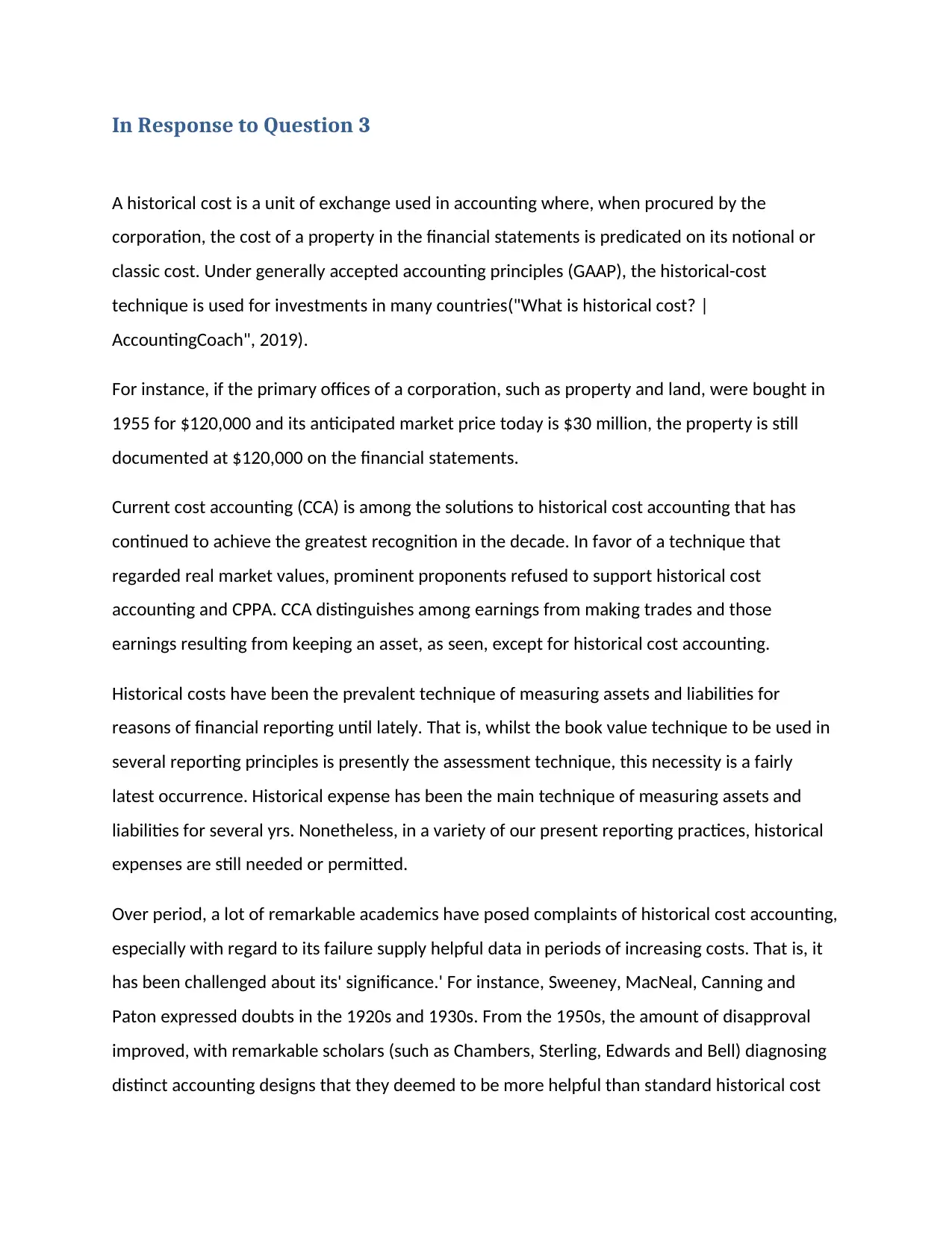
In Response to Question 3
A historical cost is a unit of exchange used in accounting where, when procured by the
corporation, the cost of a property in the financial statements is predicated on its notional or
classic cost. Under generally accepted accounting principles (GAAP), the historical-cost
technique is used for investments in many countries("What is historical cost? |
AccountingCoach", 2019).
For instance, if the primary offices of a corporation, such as property and land, were bought in
1955 for $120,000 and its anticipated market price today is $30 million, the property is still
documented at $120,000 on the financial statements.
Current cost accounting (CCA) is among the solutions to historical cost accounting that has
continued to achieve the greatest recognition in the decade. In favor of a technique that
regarded real market values, prominent proponents refused to support historical cost
accounting and CPPA. CCA distinguishes among earnings from making trades and those
earnings resulting from keeping an asset, as seen, except for historical cost accounting.
Historical costs have been the prevalent technique of measuring assets and liabilities for
reasons of financial reporting until lately. That is, whilst the book value technique to be used in
several reporting principles is presently the assessment technique, this necessity is a fairly
latest occurrence. Historical expense has been the main technique of measuring assets and
liabilities for several yrs. Nonetheless, in a variety of our present reporting practices, historical
expenses are still needed or permitted.
Over period, a lot of remarkable academics have posed complaints of historical cost accounting,
especially with regard to its failure supply helpful data in periods of increasing costs. That is, it
has been challenged about its' significance.' For instance, Sweeney, MacNeal, Canning and
Paton expressed doubts in the 1920s and 1930s. From the 1950s, the amount of disapproval
improved, with remarkable scholars (such as Chambers, Sterling, Edwards and Bell) diagnosing
distinct accounting designs that they deemed to be more helpful than standard historical cost
A historical cost is a unit of exchange used in accounting where, when procured by the
corporation, the cost of a property in the financial statements is predicated on its notional or
classic cost. Under generally accepted accounting principles (GAAP), the historical-cost
technique is used for investments in many countries("What is historical cost? |
AccountingCoach", 2019).
For instance, if the primary offices of a corporation, such as property and land, were bought in
1955 for $120,000 and its anticipated market price today is $30 million, the property is still
documented at $120,000 on the financial statements.
Current cost accounting (CCA) is among the solutions to historical cost accounting that has
continued to achieve the greatest recognition in the decade. In favor of a technique that
regarded real market values, prominent proponents refused to support historical cost
accounting and CPPA. CCA distinguishes among earnings from making trades and those
earnings resulting from keeping an asset, as seen, except for historical cost accounting.
Historical costs have been the prevalent technique of measuring assets and liabilities for
reasons of financial reporting until lately. That is, whilst the book value technique to be used in
several reporting principles is presently the assessment technique, this necessity is a fairly
latest occurrence. Historical expense has been the main technique of measuring assets and
liabilities for several yrs. Nonetheless, in a variety of our present reporting practices, historical
expenses are still needed or permitted.
Over period, a lot of remarkable academics have posed complaints of historical cost accounting,
especially with regard to its failure supply helpful data in periods of increasing costs. That is, it
has been challenged about its' significance.' For instance, Sweeney, MacNeal, Canning and
Paton expressed doubts in the 1920s and 1930s. From the 1950s, the amount of disapproval
improved, with remarkable scholars (such as Chambers, Sterling, Edwards and Bell) diagnosing
distinct accounting designs that they deemed to be more helpful than standard historical cost
Secure Best Marks with AI Grader
Need help grading? Try our AI Grader for instant feedback on your assignments.
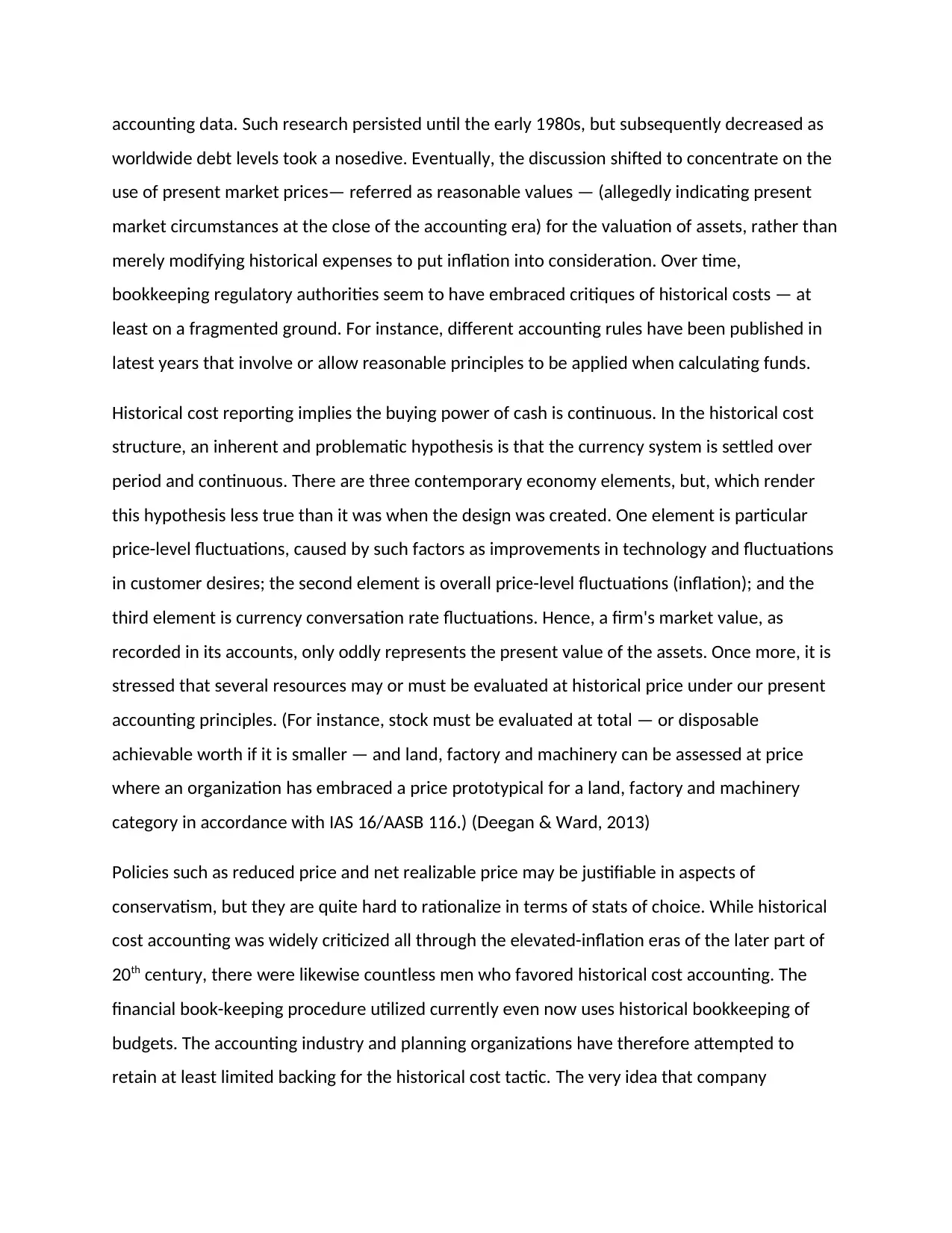
accounting data. Such research persisted until the early 1980s, but subsequently decreased as
worldwide debt levels took a nosedive. Eventually, the discussion shifted to concentrate on the
use of present market prices— referred as reasonable values — (allegedly indicating present
market circumstances at the close of the accounting era) for the valuation of assets, rather than
merely modifying historical expenses to put inflation into consideration. Over time,
bookkeeping regulatory authorities seem to have embraced critiques of historical costs — at
least on a fragmented ground. For instance, different accounting rules have been published in
latest years that involve or allow reasonable principles to be applied when calculating funds.
Historical cost reporting implies the buying power of cash is continuous. In the historical cost
structure, an inherent and problematic hypothesis is that the currency system is settled over
period and continuous. There are three contemporary economy elements, but, which render
this hypothesis less true than it was when the design was created. One element is particular
price-level fluctuations, caused by such factors as improvements in technology and fluctuations
in customer desires; the second element is overall price-level fluctuations (inflation); and the
third element is currency conversation rate fluctuations. Hence, a firm's market value, as
recorded in its accounts, only oddly represents the present value of the assets. Once more, it is
stressed that several resources may or must be evaluated at historical price under our present
accounting principles. (For instance, stock must be evaluated at total — or disposable
achievable worth if it is smaller — and land, factory and machinery can be assessed at price
where an organization has embraced a price prototypical for a land, factory and machinery
category in accordance with IAS 16/AASB 116.) (Deegan & Ward, 2013)
Policies such as reduced price and net realizable price may be justifiable in aspects of
conservatism, but they are quite hard to rationalize in terms of stats of choice. While historical
cost accounting was widely criticized all through the elevated-inflation eras of the later part of
20th century, there were likewise countless men who favored historical cost accounting. The
financial book-keeping procedure utilized currently even now uses historical bookkeeping of
budgets. The accounting industry and planning organizations have therefore attempted to
retain at least limited backing for the historical cost tactic. The very idea that company
worldwide debt levels took a nosedive. Eventually, the discussion shifted to concentrate on the
use of present market prices— referred as reasonable values — (allegedly indicating present
market circumstances at the close of the accounting era) for the valuation of assets, rather than
merely modifying historical expenses to put inflation into consideration. Over time,
bookkeeping regulatory authorities seem to have embraced critiques of historical costs — at
least on a fragmented ground. For instance, different accounting rules have been published in
latest years that involve or allow reasonable principles to be applied when calculating funds.
Historical cost reporting implies the buying power of cash is continuous. In the historical cost
structure, an inherent and problematic hypothesis is that the currency system is settled over
period and continuous. There are three contemporary economy elements, but, which render
this hypothesis less true than it was when the design was created. One element is particular
price-level fluctuations, caused by such factors as improvements in technology and fluctuations
in customer desires; the second element is overall price-level fluctuations (inflation); and the
third element is currency conversation rate fluctuations. Hence, a firm's market value, as
recorded in its accounts, only oddly represents the present value of the assets. Once more, it is
stressed that several resources may or must be evaluated at historical price under our present
accounting principles. (For instance, stock must be evaluated at total — or disposable
achievable worth if it is smaller — and land, factory and machinery can be assessed at price
where an organization has embraced a price prototypical for a land, factory and machinery
category in accordance with IAS 16/AASB 116.) (Deegan & Ward, 2013)
Policies such as reduced price and net realizable price may be justifiable in aspects of
conservatism, but they are quite hard to rationalize in terms of stats of choice. While historical
cost accounting was widely criticized all through the elevated-inflation eras of the later part of
20th century, there were likewise countless men who favored historical cost accounting. The
financial book-keeping procedure utilized currently even now uses historical bookkeeping of
budgets. The accounting industry and planning organizations have therefore attempted to
retain at least limited backing for the historical cost tactic. The very idea that company
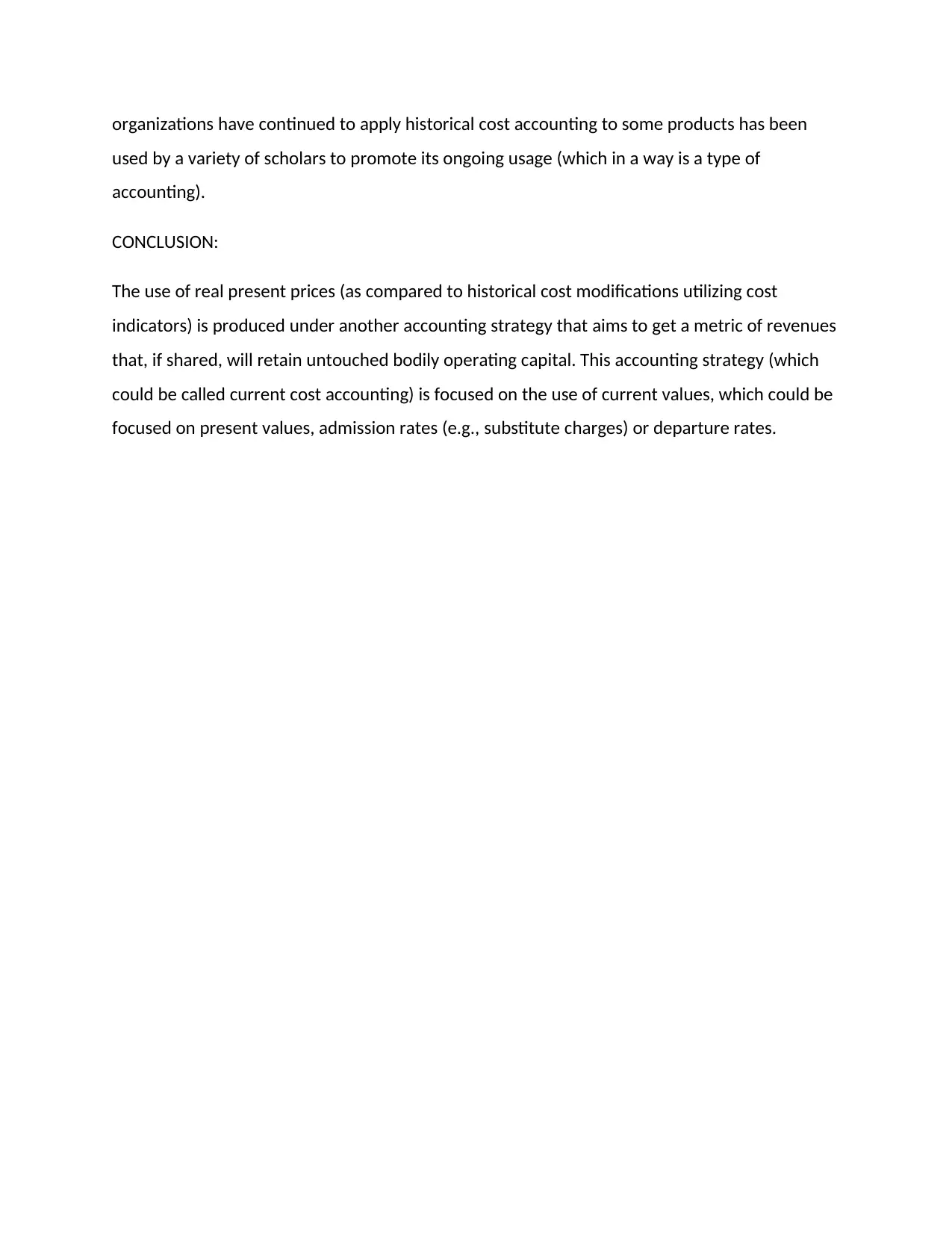
organizations have continued to apply historical cost accounting to some products has been
used by a variety of scholars to promote its ongoing usage (which in a way is a type of
accounting).
CONCLUSION:
The use of real present prices (as compared to historical cost modifications utilizing cost
indicators) is produced under another accounting strategy that aims to get a metric of revenues
that, if shared, will retain untouched bodily operating capital. This accounting strategy (which
could be called current cost accounting) is focused on the use of current values, which could be
focused on present values, admission rates (e.g., substitute charges) or departure rates.
used by a variety of scholars to promote its ongoing usage (which in a way is a type of
accounting).
CONCLUSION:
The use of real present prices (as compared to historical cost modifications utilizing cost
indicators) is produced under another accounting strategy that aims to get a metric of revenues
that, if shared, will retain untouched bodily operating capital. This accounting strategy (which
could be called current cost accounting) is focused on the use of current values, which could be
focused on present values, admission rates (e.g., substitute charges) or departure rates.
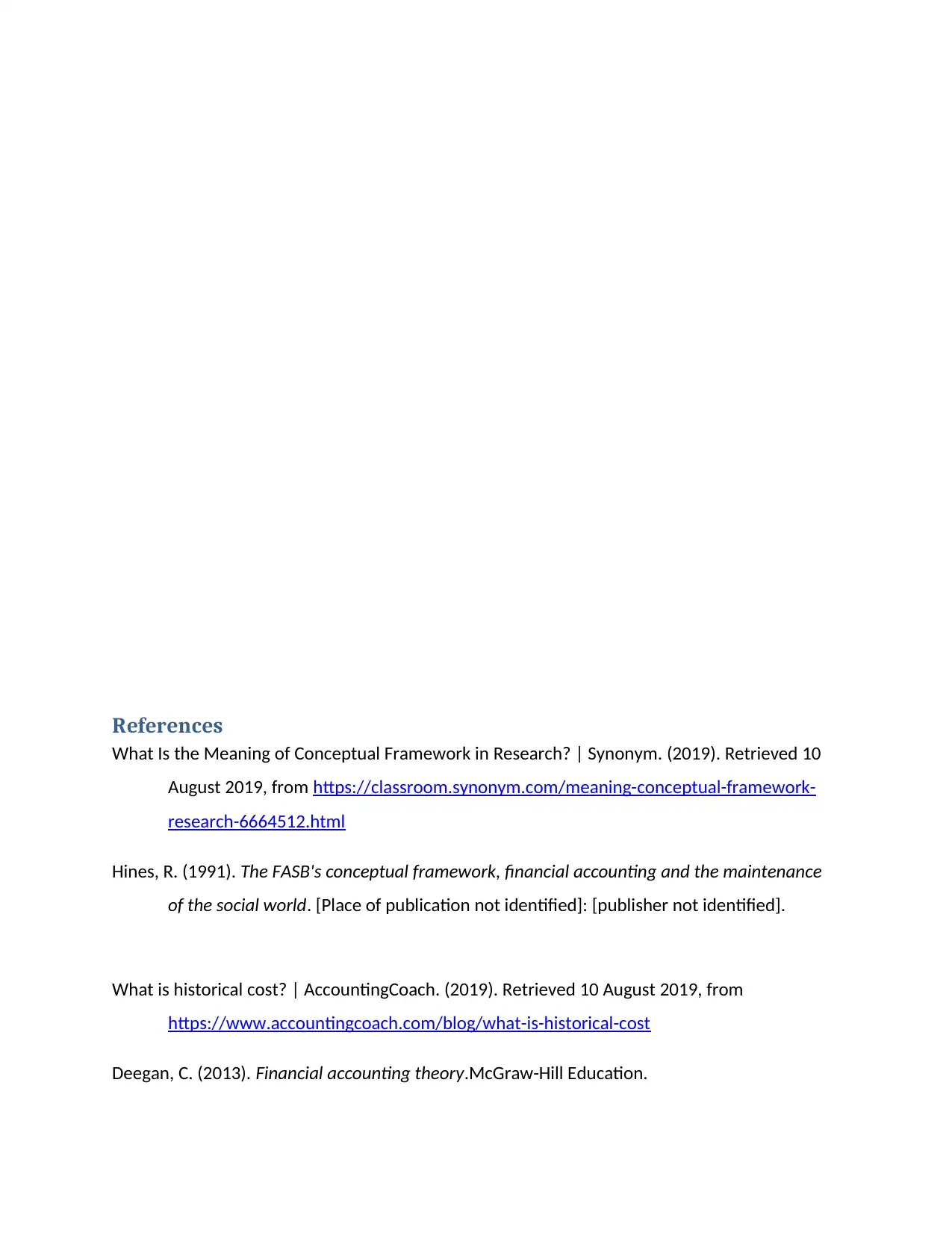
References
What Is the Meaning of Conceptual Framework in Research? | Synonym. (2019). Retrieved 10
August 2019, from https://classroom.synonym.com/meaning-conceptual-framework-
research-6664512.html
Hines, R. (1991). The FASB's conceptual framework, financial accounting and the maintenance
of the social world. [Place of publication not identified]: [publisher not identified].
What is historical cost? | AccountingCoach. (2019). Retrieved 10 August 2019, from
https://www.accountingcoach.com/blog/what-is-historical-cost
Deegan, C. (2013). Financial accounting theory.McGraw-Hill Education.
What Is the Meaning of Conceptual Framework in Research? | Synonym. (2019). Retrieved 10
August 2019, from https://classroom.synonym.com/meaning-conceptual-framework-
research-6664512.html
Hines, R. (1991). The FASB's conceptual framework, financial accounting and the maintenance
of the social world. [Place of publication not identified]: [publisher not identified].
What is historical cost? | AccountingCoach. (2019). Retrieved 10 August 2019, from
https://www.accountingcoach.com/blog/what-is-historical-cost
Deegan, C. (2013). Financial accounting theory.McGraw-Hill Education.
1 out of 13
Your All-in-One AI-Powered Toolkit for Academic Success.
+13062052269
info@desklib.com
Available 24*7 on WhatsApp / Email
![[object Object]](/_next/static/media/star-bottom.7253800d.svg)
Unlock your academic potential
© 2024 | Zucol Services PVT LTD | All rights reserved.
